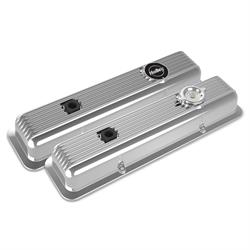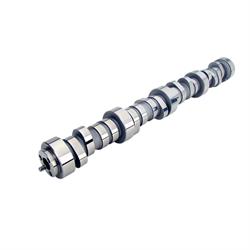Project Chevelle: 383 vs. LS Shootout Tech Article
One fundamental belief that most gearheads share is the idea that we are doing it the “right” way. We have faith in our own vision and abilities and often fail to see the wisdom of those who want to follow a different path. If you’ve lived and breathed Fords for a lifetime, Chevy fans might not make much sense to you. Similarly, if you’ve been building traditional small or big block Chevy engines forever, it can be difficult to get on board with modern powerplants. On the other hand, if the IROC Camaro that you drove in high school got beat up on by LS-powered fourth-gen Camaros and Firebirds, you may think those modern marvels are the only way to go fast. This can lead to some heated debate about which one is really the “right” choice.
Whatever path you choose, we can all agree that we want to go fast for cheap. In that quest, we have tried a couple different engines in our Project Chevelle. We’ve also kept all the receipts, and now it’s time for some answers. Between our 383 crate motor and junkyard LQ9 swap, which one really delivered the most bang for the buck?
The 383
We used an off the shelf crate engine from BluePrint Engines that was advertised at 420 horsepower and 450 ft. lb. This engine includes an HEI distributor, intake manifold, valve covers, and oil pan. We added a 770 Holley Street Avenger carb and chose an MSD distributor to replace the HEI. We also added a few dress-up items to make it look more at home in our vintage engine compartment. The total for the engine and all the parts on it was $6,766.89. Here’s the complete list:
BluePrint claims that this engine makes 420 horsepower and 450 ft. lbs. of torque. After a few easy tweaks to the MSD Digital E-Curve distributor and the Holley carb, ours made 431 horsepower at 5,300 rpm and a stump-pulling 452 ft. lbs. at 4,000. Not bad.
Driving Impressions
This was the first engine to go in the car after the wheezy stock 307. As you can imagine, the difference was dramatic. As you can see on the dyno sheet, it was already making 432 ft. lbs. at 3,000 rpm. That made it hard to casually leave from the traffic light without spinning the tires. It idled happily around 900 rpm, but still had a little lope, just like a muscle car should. With this engine, the Chevelle was one of those muscle cars that we remember from when we were kids; loud, lopey, fast, and full of attitude. This engine also covered over 700 miles to the Street Rod Nationals in Louisville without any problems, and we were smiling at the end of every day driving it there.
The LS
It’s an LQ9 from an ’04 Escalade. It arrived at our shop just as it was pulled; a little crusty, a little ugly, but full of promise. When we opened it up, we were pleased to see that it was in pretty good shape. The piston skirts were a little scuffed, but otherwise it was a great starting point. We cleaned up the block with a hone, did a standard valve job and surfaced the heads. Mahle flat top pistons replaced the stockers, and the rotating assembly was balanced.
The magic ingredient in this setup was the Comp cam. It measures .607” intake lift and .614” exhaust, with 219 degrees of duration on the intake and 227 on the exhaust (both at .050) on a 112 degree LSA. The rocker trunnions were also upgraded with Comp pieces to cope with the extra lift, but otherwise this engine is pretty darn stock. The FiTech intake and ECM were a bit of a splurge, but the improvement in appearance and tuneability over the stock junkyard stuff was pretty dramatic. Ready to run, we had $8,189 in this engine. Here’s the list:
We guessed 450 horsepower. We were wrong. After a few cautious pulls, we tinkered with the FiTech to add a bit more fuel throughout the rpm range and let it spin all the way to 6800rpm. We ended up making 496 horsepower at 6,200 rpm and 459 ft. lbs. at 5,100. That’s not too shabby for a naturally aspirated 364 cubic inch engine.
Driving Impressions
Immediately after installing the engine, we threw the Chevelle in a trailer bound for LS Fest in Bowling Green. It came off the trailer, did a couple hole shots on the return road, and went right to the staging lanes. The car ended up running a 13.6 at 105mph. Not bad, but we know we can do better. There was a gnarly exhaust leak right at the head that was giving our O2 sensor fits and we were on the same street tires that had driven us to Louisville. This combination has 12’s in it, and we hope to get a chance to prove it.
Some will say that the real cost of an LS swap comes from the various pieces needed to transplant them into the car. In our case, we installed a new clutch, bellhousing, motor mounts, headers, and radiator with both the 383 and the LS, so the cost was actually very similar. If you already have parts made to handle power behind a different engine, then there will be some additional costs, as with any engine swap.
At idle, it’s hard to believe that this car has a 500-horse engine. It idles like a stock Silverado pickup, and doesn’t really start to sound like a hot rod until you wind it up a bit. From 3000 to 7000 rpm, the rumble becomes a wail, and it seems to pull harder all the way to the redline. Compared to the 383, this engine feels a bit softer right off the bottom, but that incredible pull and the amazing scream through the exhaust as the revs come up is addictive. It makes you want to drive more aggressively and keep it wound up, even when you’re in traffic around town. The 383 rewarded a smooth driving style, whereas the LS wants to be driven hard. This combination is far more likely to get us into trouble.
In Conclusion
If our only objective had been dirt cheap horsepower, we could have saved money on both engines. The 383 didn’t need the fancy air cleaner or valve covers. Also, that MSD starter isn’t cheap, but we’ve found them to be almost bulletproof cranking over 13:1 race engines. We could have left the ugly HEI in place, and it didn’t absolutely have to have power steering.
As for cost saving on the LS, we probably could have skipped the rebuild altogether. People are constantly plucking these right out of the junkyard and blasting them with nitrous or turbo abuse. In that respect, the LS platform has an advantage over the old-school engines; the bottom end and cylinder heads will support more power in stock form than a junkyard Gen I small or big block. In our case, the LQ9 is the high-compression version of the more common LQ4 6.0, and simply changing the cam might have shown similarly big power. There’s also a much cheaper harness and ECM-only version of the FiTech kit that re-uses the stock intake manifold, throttle body, and fuel rails.
Our conclusion? There are a million ways to make power and go fast. The performance aftermarket has made it easy to do that with just about any engine out there, and every build is going to be different. We made our 383 and LS look and perform exactly the way we wanted them to. The LS ended up costing about $1400 more than the 383, but it made significantly more power. Had we made different choices, the scales could have tipped dramatically in either direction. At the end of the day, we proved to ourselves that the good old small block Chevy is still a viable performance engine that looks just right under the hood. We also proved that an LS-swap does not require a master’s degree in electrical engineering. When done right, they are a plug and play operation that will make big power and start on the first turn of the key. We’ll leave it to you to determine which one looks the best in your engine compartment.
Note: The BluePrint 383 that we used has been discontinued from our catalog and replaced with a roller cam version that makes even more power! It’s rated at 430 horse, which is 10 more than the old one. Check it out here.
By the way, have you wondered what happened to the 383 that we pulled from the Chevelle? We’re happy to report that it’s led quite the adventurous life since this article was written. We added a 4-71 blower and dropped it into a '32 Roadster. You can read more about it here.



